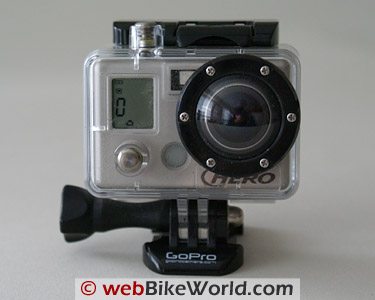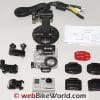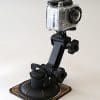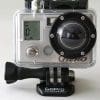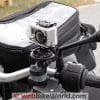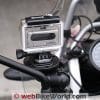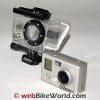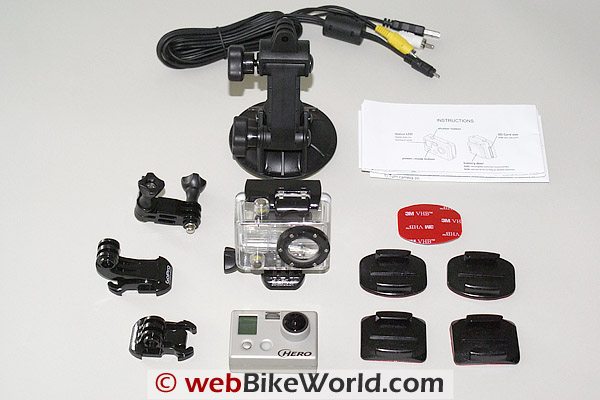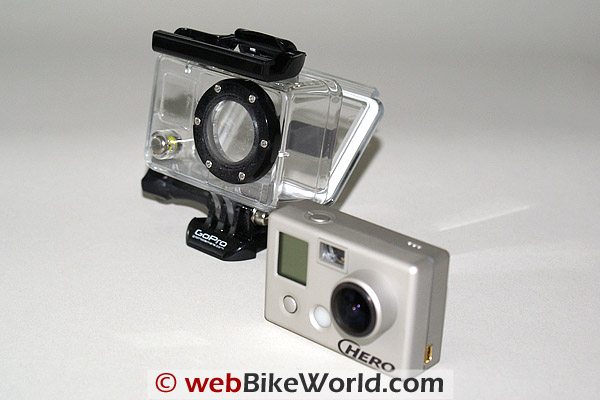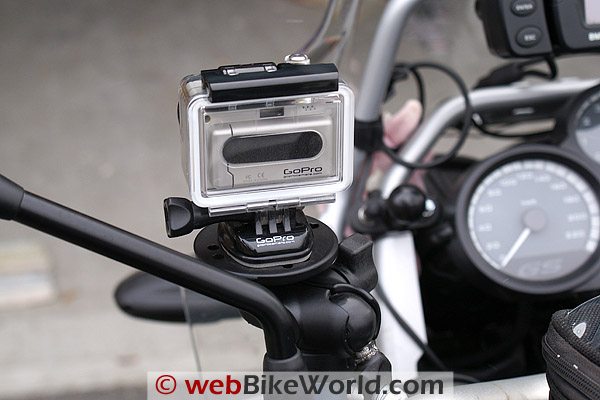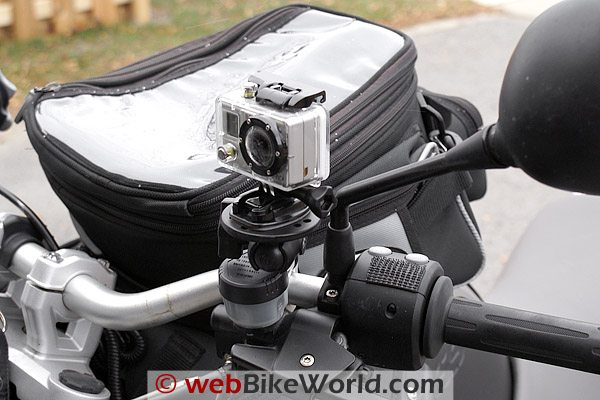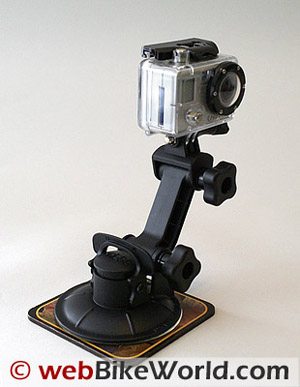What’s not to like? A 170-degree wide angle lens, 5-megapixel wearable or vehicle mountable camera.
Extremely simple to configure and use. Just as simple to play back video or view still shots.
My words from the original GoPro HERO camera review published last February, “buy it, use, enjoy it and if necessary, share it” still apply and probably more so with this new release.
While still not the most technically advanced camera available, it is still one of the most competent and versatile cameras for the money.
With its lens, resolution enhancements and additional mounting components, the price delta between the original and this updated model is more than worth it.
The original webBikeWorld GoPro camera review was published in February of 2008 and ever since then I have anxiously awaited the arrival of a wide angle option and higher resolution for the camera. The wait is finally over.
After making a phone call to a local reseller, 24 hours later a new GoPro HERO Wide Angle camera kit was delivered into my waiting hands, for the purchase fee of course, plus taxes.
I was so anxious to get it mounted on the F800GS that the camera simply got pulled out of its clear packing case and with two lithium batteries loaded and a 2 GB high-speed SD card inserted into the slot, the little camera that can was ready to go.
With expediency being the word of the day, the camera in its clear waterproof housing quickly got mounted on to an existing GoPro adapter, itself adhered to a RAM camera plate mount on the left handlebar.
That done, off I went — instructions are sometimes secondary! But I digress; back to the start.
An Even More Attractive Package
A big part of the whole upgrade is reflected in the additional goodies residing in the bottom half of what is one of the most attractive display packages on the market.
The bottom box is black while the upper half is actually a clear plastic case showcasing the camera in its housing mounted on a quick release mount – it looks ready to go right in the box.
The top part of the package is almost a work of art by itself: the stuff in the bottom isn’t shabby either.
The revised package includes: the camera and the quick-release waterproof housing that is good to 30 meters (100 feet).
It also includes a quick release buckle, a (new) vertical surface quick release buckle, two flat and two curved surface mounts with very strong 3M VHB 4991 adhesive pads; and, the side-mount pivot arm.
And one more thing, which is probably the most interesting and welcome addition to the kit — a really powerful suction cup mount with two pivot points.
Rounding out the tightly packed accessories in the bottom of the box is a combined mini-USB to USB and RCA connector jacks (audio and video).
Change is Good, Right?
Visually similar and dimensionally the same, this new unit is so much better than its predecessor in so many ways.
The biggest change, literally, is that honking big fish-eye style lens that dominates the front left zone.
It still shoots at 30 frames per second (fps), but with a 170 degree view of the world, a five megapixel still photo capability (up from 3MP on the original).
It has single, photo-every-two or photo-every-five seconds and triple-shot-sequence modes, greatly improved low light performance and at least from my perspective, a much improved audio capture capability.
A 2 GB SD card (a high speed card or better is recommended) will give you 56 minutes of 512 x 384 resolution video or approximately 1940+ photos, as long as your batteries are up to the task.
The Wide-Angle View
I think everyone is pretty familiar with the oft heard or seen statement, “Please remain behind the line…”
With this new GoPro this is pretty much an absolute – it is very important to modify the hand grip, use an adapter as a handle or leave it mounted on whatever.
Otherwise the fingers or other parts of the anatomy will appear in undesirable cameo roles.
For still photo work, the Power/Mode button is pressed repeatedly to toggle between the small icons. A single miniature camera indicates ‘still’ mode and when its blinking the camera is in ‘every two/five seconds mode’.
When the triple shot icon shows up, you are in (surprise) the triple-shot sequence mode.
Pressing the top shutter button will start the picture taking sequence, indicated by the flashing red light which will flash for each shot taken, no matter the sequence mode. Pressing the shutter again will stop the session.
Video mode is the default power on mode, although this can be changed via the settings menu as desired. With the small video icon selected, point the camera in the right direction and push the Shutter button firmly.
The small Red light keeps blinking while video capture mode is enabled.
A short audio tone is also generated whenever the shutter is started or stopped.
Settings
A couple of changes have been made to the settings menu to accommodate the triple shot and every two/five-seconds mode.
Getting to the settings menu is still the same procedure – toggle the Power/Mode button to the SET icon, push the Shutter button once to access settings mode and push the Power/Mode button to cycle through the setting options.
To step through the choices for each option, press the Shutter button. To save a particular choice, press the Power/Mode button once and then proceed to the next setting.
Reading through the well written instructions provided on a large multi-language fold-out sheet is time well spent.
If this is followed by a few minutes of cycling though the choices for familiarization, selecting the desired settings and then saving everything off, you will be off to a good start.
The camera is really very easy to operate and once settings are understood, the camera can be quickly configured or reconfigured for any specific situation or set of conditions.
Audio Wellness
My experience with the camera has identified that the HI/LO sound settings for videos is one of the most important option settings to understand and use properly.
The LO setting is what I normally use as it is optimized to deal with vibration and other low-frequency sounds typical in a very noisy (riding) environment.
The HI setting works great if the unit is mounted on a helmet, worn on the arm or wrist, or possibly inside a vehicle. However, as with picture and video taking, some experimentation with the settings will pay dividends in the long run.
I have noticed that the audio capture from this 170 Wide Angle model is far better than my original model.
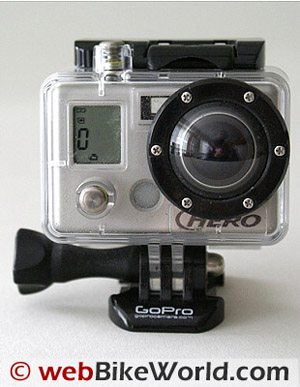
File Management On The Fly
Deleting shots or files can be done by using the camera controls or via the PC interface.
If storage space is at a premium, either the last shot or video, or everything captured can be deleted literally on the fly.
To delete the last shot, toggle the Power/Mode button to the DELETE LAST icon, represented by a single square with a line through it, then press the Shutter button.
To delete everything in memory, toggle to the DELETE ALL icon represented by three squares with a line through them.
Then press the Shutter button — the icon will flash for five seconds and if the Shutter button is pushed again within this period all files will be deleted.
External manipulation of the still shots and videos captured on the 16MB internal memory or an external SD storage card can be done two basic ways; using the USB interface cable or by removing the SD card and reading it via a card reader interface.
In any case, simply browse to the DCIM100GOPRO folder or icon and open it -the files will be there.
Working With Less
Another big improvement in the whole image collection process regards light. Using this new version in low light conditions (indoors or outside) is much, much improved over the original version.
Although I can’t really quantify the degree of change, it is significant and just serves to further enhance the versatility of this camera.
The Power Grid
GoPro is very specific in pointing out that the right battery makes all the difference and they are absolutely right. Rechargeable NiMH or Lithium units provide the best option.
I favour lithium cells overall as they last three to four times longer than anything else and their efficiency is not degraded when it gets (really) cold…to bad I’m not the same way!
When the batteries are low, the small LCD in the upper right corner will blink and eventually the camera will automatically power down.
One of the first clues to a degraded power situation, outside of the visual indicator, is that the camera will shoot only short videos and then stop – in this instance the camera is actually auto-saving the file before power disappears…
Regardless of what you use for power, just remember to recycle the cells appropriately and don’t forget that rechargeable units will run down over time with multiple recharges, losing some of their original efficiency.
This is one reason why I use one or two sets of rechargeable cells for normal short duration use but when the camera is going to be on for prolonged periods of time and likely fill the SD card up, the lithium cells are installed.
Vive la Différence!
[asa2 tplid=”6″]B00NIYNUF2[/asa2]Outside of the lens size and the changes made to the settings menu, there is not much to distinguish the Wide Angle model from its sibling, until its put into action.
As can be appreciated, with a 170 degree lens at work, the view in front tends to become a bit bigger, but not without some of the inherent ‘distortion’ common to this type of lens.
As you can see from the comparative shots and the short video clips, the view captured by this camera is quite amazing – if you want the centre, up, down and sideways, this is the device to do it with.
With the right positioning on a motorcycle for maximum effect and when played back on a large screen, you are virtually one with the camera.
GoPro Wide Samples
Here’s a sample video of the Calabogie Run (Note: This was a .wmv file processed in DivX and uploaded to YouTube, which degrades the original quality).
Photos: Following are unretouched .jpg files, resized to 600 px wide but otherwise unedited.
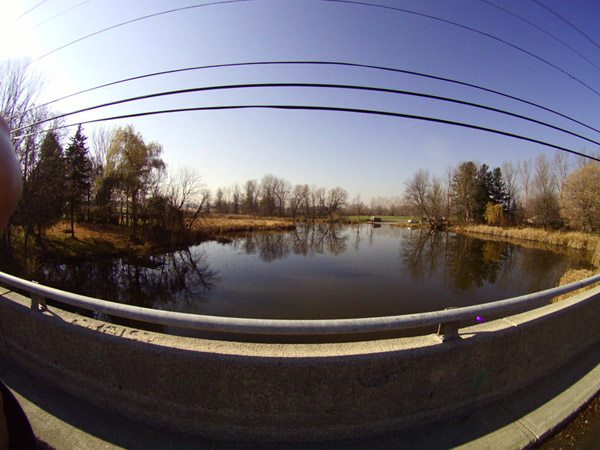

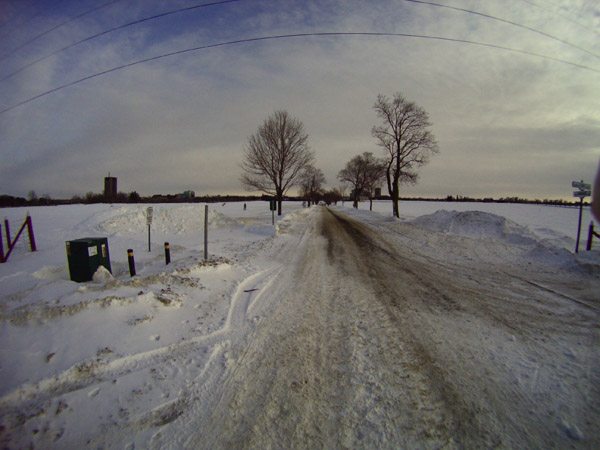
GoPro Wide Specifications
- Sensor: 5 megapixel sensor with a 170 degree glass lens and automatic exposure.
- Video: TV-quality 512 x 384 video with mono sound; file default is .AVI.
- Stills: Single, 3X photo-burst and 2-shot stop-action modes, file default is .JPG
- Memory: Internal is 16MB, External is expandable with SD card (up to 2 GB).
- Power: Two (2) AAA batteries (high output rechargeable or lithium units recommended), battery life of up to 4.5 hours or even longer is possible depending on the cells used, lithium batteries are recommended by the manufacturer to provide the best performance under all temperature and vibration conditions.
- Interface: USB cable and RCA plugs, MS ME/2000/XP/Vista and MAC operating systems are supported.
Conclusion
The five megapixel resolution pictures are a noticeable improvement over the previous three megapixel limitation and in a time when double digit megapixel cameras are fast becoming the norm this resolution for most applications is just fine.
Video resolution remains unchanged per se, but video playback is far smoother than its predecessor — something good got done here as well.
There are some excellent demonstration videos posted on the GoPro website and literally hundreds of examples to be found via a web search.
There are other small portable video cameras available or coming to market that go or will go head to head with the GoPro for quality and price, but for versatility, completeness, ease of use and reliability, this kit is still unmatched.
Keep the camera, its waterproof housing clean and always use high quality batteries and it will give you many great pictures and exciting videos to share or just quietly reflect upon on when riding is not an option.
Next: Part 2: Notes on the GoPro Wide (includes video tour of the camera)
More webBikeWorld:
▪ Video Action Camera Reviews
▪ Intercom and Radio Reviews
| wBW Review: GoPro Wide Camera | |
|---|---|
| Manufacturer: GoPro | List Price (2009): $189.99 USD. Canadian price typically around $230.00 CAD |
| Colours: Silver | Made In: China |
| Review Date: February 2009 | |
Owner Comments and Feedback
See details on submitting comments.
From “L.T.” (7/09): “Just wanted to comment a little on the GoPro Wide camera I recently purchased.
I received my GoPro Hero Wide, and almost immediately opened the box and tried it out just walking around the house. Seemed to work just fine. It produced a good picture, and even seemed to adjust quickly and well to changing light conditions.
I found some PNY 2 GB memory cards on sale for $7 US and bought 3 of them in anticipation of getting out and riding, as well as some rechargeable NiMH batteries.
Unfortunately, the camera would just not seem to stay on. I’d be lucky to get 5-10 secs of footage and it would just shut off. Sometimes, I couldn’t even get it to turn on, even though I just put freshly recharged batteries in it.
The red light would come on for a split second, then just shut off and the camera would be ‘dead’.
So I sent the camera back, thinking I had just got a ‘lemon’.
Problem is that the second camera did the exact same thing! So now I’m beginning to think it’s a minor design flaw, since so many others have clearly managed to get the camera working.
After some experimenting, it turns out the camera works just fine.
The problem is that there is no positive locking mechanism on the camera to hold the memory card in place. The memory stick is just held against the spring by the camera inside the waterproof case.
If the memory card is slid out, the camera shuts itself off.
So the memory cards were just at the edge of the the minimum length to not allow the camera to stay on when inside the case. (I held the card firmly in with my hand, while using the camera outside the case, and it worked fine.)
My solution was to wedge a dime between the side of the camera and the case when it is secured. Now it works fine (and my first video is posted at wBW, thanks!).
I’m not sure if the PNY cards’ plastic cases are a half millimeter too small compared to some other, or I was just a victim of bad tolerance stack up, but it was rather frustrating thinking I had gotten two bad cameras.
Maybe some of your readers can benefit from my lessons learned.”
Editor’s Note: I usually buy the “best” (i.e., 1st tier supplier) brands of memory cards, even though they cost a few extra bucks. This is especially important for video, which needs the fastest read/write times you can get.
However, PNY is a decent brand, so it may be that the camera’s memory slot tolerances are out of whack.


